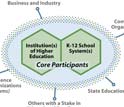|

Press Release 06-029
NSF's Math and Science Partnerships Make the Grade

Early analysis shows K-12 student proficiency rising with new educational approaches
February 9, 2006
Elementary, middle- and high-school students participating in the National Science Foundation's (NSF) Math and Science Partnership (MSP) program during the 2002-2003 and 2003-2004 school years showed significant improvements in mathematics proficiency test scores, according to a first analysis of data the foundation has gathered.
During the same period, MSP elementary school students showed significant gains in science proficiency.
But, high-school math students showed the greatest improvement with 14.2 percent more "at or above proficiency" after one year of MSP participation. Elementary school students performed better in both math and science with 7.3 and 8.6 percent more reaching or exceeding proficiency, respectively.
These data, the first available since MSP's establishment in 2002, were collected from 130 partnership schools that received first-round awards.
"It was very exciting for everyone to see that high school math students could reverse the typical trend of declining scores," said Diane Spresser, senior program coordinator for MSP at NSF.
The NSF-MSP program supports partnerships among higher education, local K-12 school systems and supporting stakeholders, such as businesses or informal science education organizations. At a minimum, each partnership must contain one institution of higher education and one K-12 school system.
The University of Massachusetts, Boston, for example, collaborates with Northeastern University and the Boston public school system to form the Boston Science Partnership's (BSP) core. The Harvard Medical School and the College Board are supporting partners. The BSP potentially impacts more than 23,000 science students in grades 6-12.
The University of Kentucky leads the Appalachian Mathematics and Science Partnership (AMSP) of Ky., Va., and Tenn. to improve math and science achievement for almost 170,000 students. AMSP connects 10 institutions of higher education with 38 school districts in Ky., nine in Tenn., and five in Va.
Example MSP efforts include after-school, weekend and summer enrichment activities for students, professional development activities for teachers, revised math and science curricula, and new teacher training programs at participating universities.
"MSP is engaged in an expansive strategy to learn what works and what doesn't, for whom, and under what circumstances. As more data come in, we'll get a better understanding of how to approach math and science education to maximize student potential," Spresser said.
The COSMOS Corporation, faculty at Brown University, George Mason University and Vanderbilt University are working collaboratively to analyze incoming data. Using data collected by the Partnerships since inception, the evaluation began in 2004 and covers the entirety of the program's activities.
"Although the scope of MSP activities makes for a challenging evaluation, assessments of educational tools and approaches are necessary for the long-term success of our nation's educational enterprise," commented Robert Yin, principal investigator at COSMOS.
Through MSP, NSF assumed important responsibilities to build capacity for implementing the President's No Child Left Behind vision for K-12 education. The program seeks to improve K-12 student achievement by focusing on three inter-related issues:
- ensuring student participation and success in challenging and advanced math and science courses
- enhancing the quality, quantity and diversity of the K-12 math and science teacher workforce
- developing evidence-based outcomes to increase the understanding of how students best learn math and science
Forty-eight partnerships and more than 30 other tool-development and evaluation projects comprise NSF's current MSP portfolio, representing a total investment of nearly $600 million to date. NSF's research and development MSP complements programs at the U.S. Department of Education that disseminate educational tools and strategies to all 50 states via formula funds.
After a complete analysis of the data, results from the first-year evaluation will be publicly available at the NSF's MSP Web site in spring 2006. Math and Science Partnership data will be evaluated for at least three more years.
-NSF-

Media Contacts
Neysa Call, NSF (703) 292-8430 ncall@nsf.gov
Program Contacts
Diane M. Spresser, NSF (703) 292-4600 dspresse@nsf.gov
Co-Investigators
Robert K. Yin, COSMOS Corporation (301) 215-9100 ryin@cosmoscorp.com

The National Science Foundation (NSF) is an independent federal agency that
supports fundamental research and education across all fields of science and
engineering, with an annual budget of $6.06 billion. NSF funds reach all 50
states through grants to over 1,900 universities and institutions. Each year,
NSF receives about 45,000 competitive requests for funding, and makes over
11,500 new funding awards. NSF also awards over $400 million in
professional and service contracts yearly.
 Get News Updates by Email Get News Updates by Email
Useful NSF Web Sites:
NSF Home Page: http://www.nsf.gov
NSF News: http://www.nsf.gov/news/
For the News Media: http://www.nsf.gov/news/newsroom.jsp
Science and Engineering Statistics: http://www.nsf.gov/statistics/
Awards Searches: http://www.nsf.gov/awardsearch/
| 




